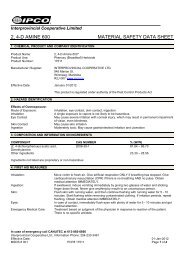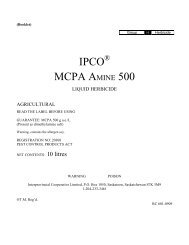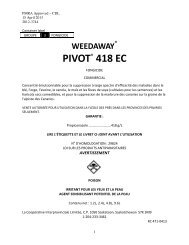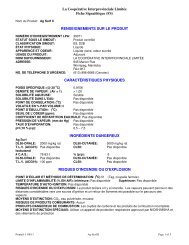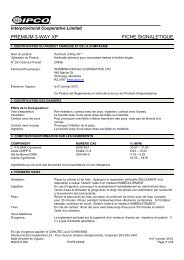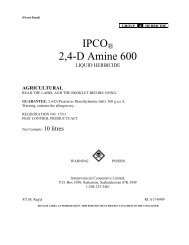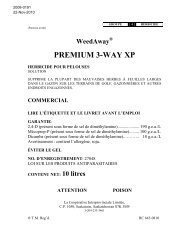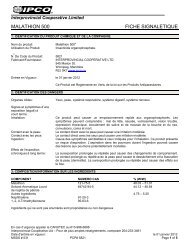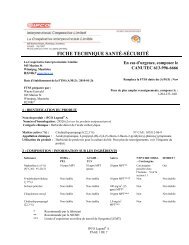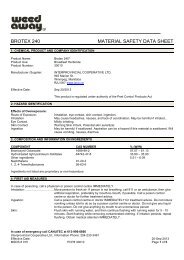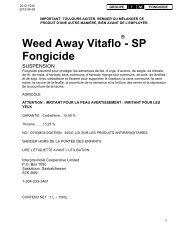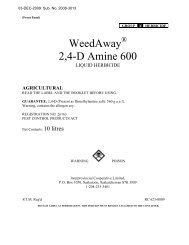Citadel Label - Interprovincial Cooperative Limited (IPCO)
Citadel Label - Interprovincial Cooperative Limited (IPCO)
Citadel Label - Interprovincial Cooperative Limited (IPCO)
You also want an ePaper? Increase the reach of your titles
YUMPU automatically turns print PDFs into web optimized ePapers that Google loves.
equipment. Spilled material should be soaked up with absorbent material and disposed of in an approvedmanner.HAZARDSTOXIC to birds, wild mammals and bees exposed to direct treatment, drift, or residues on blooming plants.Do not use on flowering crops or weeds. TOXIC to certain beneficial insects. Minimize spray drift toreduce harmful effects on beneficial insects in habitats next to the application site such as hedgerows andwoodland. DO NOT apply this product or allow it to drift to flowering crops or weeds if bees are visitingthe treatment area. Applicators should inform local bee keepers prior to application if hives are in adjacentfields. Minimize spray drift to reduce harmful effects on bees in habitats close to the application site.To reduce runoff from treated areas into aquatic habitats, consider the characteristics and conditions of thesite before treatment. Site characteristics and conditions that may lead to runoff include, but are not limitedto, heavy rainfall, moderate to steep slope, bare soil, poorly draining soil (e.g., soils that are compacted orfine textured such as clay). Avoid application of this product when heavy rain is forecast. Contamination ofaquatic areas as a result of runoff may be reduced by including a vegetative strip (buffer zone) between thetreated area and the edge of the water body.Buffer Zones for Protection of Aquatic HabitatsFor all applications: DO NOT apply during periods of dead calm. Avoid application of this product whenwinds are gusty.For aerial applications: DO NOT apply when wind speed is greater than 16 km/h at flying height at thesite of application. The nozzle type is restricted to CP ® , with the following set-up restriction:Nozzle typeCP ®RestrictionDO NOT use greater than 30° deflectionBuffer ZonesThe buffer zones specified in the following tables are required between the point of direct application andthe closest downwind edge of sensitive freshwater habitats (such as lakes, rivers, sloughs, ponds, prairiepotholes, creeks, marshes, streams, reservoirs and wetlands), estuarine habitats and marine habitats.Aerial ApplicationsFor all aerial applications, a buffer zone of 100 metres is required for the protection of aquatic habitats.Field Sprayer Applications 1, 2Rate of Application ( L/ha) Buffer Zones (metres) Required for the Protection ofAquatic Habitats with Water Depths Of:< 1 metre 1–3 metre > 3 metreUp to 576 50 40 30Greater than 576 and less than or 55 45 35equal to 1152Greater than 1152 and up to 2304 60 50 401 For field sprayer application, buffer zones can be reduced with the use of drift reducing sprayshields. When using a spray boom fitted with a full shield (shroud, curtain) that extends to thecrop canopy or ground, the labelled buffer zone can be reduced by 70%. When using a sprayboom where individual nozzles are fitted with cone-shaped shields that are no more than 30 cmabove the crop canopy or ground, the labelled buffer zone can be reduced by 30%.2 Buffer zones are not required for treatments applied as a drench (i.e., drench applications forcontrol of cabbage maggot, onion maggot and seedcorn maggot).6



